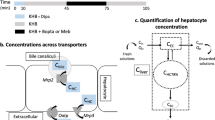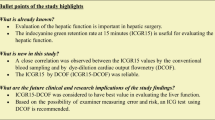Summary
Hepatic distributional volumes were investigated in the in situ perfused rat liver. Perfusion experiments were conducted using Krebs bicarbonate buffer delivered via the portal vein in single-pass mode at a total flow rate of 15 mL/min. A bolus dose of normal erythrocytes (RBC, vascular marker) and Evans blue (EB, extracellular marker) respectively was administered in the presence and absence of protein. At the end of the experiment, liver total water content was determined by desiccation and freeze-drying methods. Similar moment analysis results and superimposable effluent curves were obtained in the presence (RBC, mean transit time [MTT: 7.31±0.45 s and volume of distribution [V]: 0.17±0.01 mL/g; EB, MTT: 10.9+0.62 s and V: 0.25+0.02 mL/g) and in the absence (RBC,MTT: 7.55±0.84 s and V: 0.18+0.02 mL/g; EB,MTT: 9.24±0.77 s and V: 0.20±0.02 mL/g) of protein, which indicates that the hepatic distribution of RBC and EB within the liver is not influenced by protein. Furthermore, the almost identical results obtained with the desiccation and freeze-drying methods clearly suggest that the freeze-drying method can be used as an alternative to desiccation for the estimation of liver water content.
Similar content being viewed by others
References
Law R.O. (1982): Techniques and applications of extracellular space determination in mammalian tissues. Experientia, 38(4), 411–421.
Norwich K.H. (1977): Molecular dynamics in biosystems: the kinetics of tracers in intact organism. Pergamon Presss, Oxford.
Trautman E.D., Newbower R.S. (1984): The development of indicator-dilution techniques. IEEE Trans. Biomed. Eng., 31(12), 800–807.
Bassingthwaighte J.B. (1986): Transport of small molecules across the capillary: assessment via multiple indicator dilution methods. In: Baker CH., Nastuk W.L. (eds). Microcirculatory Technology. Academic Press Inc., London, pp. 447–470.
Sahin S., Rowland M. (1998): Development of an optimal method for the dual perfusion of the isolated rat liver. J. Pharmacol. Toxicol. Methods, 39(1), 35–43.
Sahin S., Karabey Y., Kaynak M.S., Hincal A.A. (2006): Potential use of freeze-drying technique for estimation of tissue water content. Methods Find. Exp. Clin. Pharmacol., 28(4), 211–215.
Pang K.S., Lee W.F., Cherry W.F., Yuen V., Accaputo J., Fayz S., Schwab A.J., Goresky C.A. (1988): Effects of perfusate flow rate on measured blood volume, disse space, intracellular water space, and drug extraction in the perfused rat liver preparation: characterization by the multiple indicator dilution technique. J. Pharmacokinet. Biopharm., 16(6), 595–632.
Roberts M.S., Fraser S., Wagner A., McLeod L. (1990): Residence time distributions of solutes in the perfused rat liver using a dispersion model of hepatic elimination: 1. Effect of changes in perfusate flow and albumin concentration on sucrose and taurocholate. J. Pharmacokinet. Biopharm., 18(3), 209–234.
Roberts M.S., Fraser S., Wagner A., McLeod L. (1990): Residence time distributions of solutes in the perfused rat liver using a dispersion model of hepatic elimination: 2. Effect of pharmacological agents, retrograde perfusions, and enzyme inhibition on evans blue, sucrose, water, and taurocholate. J. Pharmacokinet. Biopharm., 18(3), 235–258.
Pang K.S., Barker F. 3rd, Schwab A.J., Goresky C.A. (1990):l4C-urea and58Co-EDTA as reference indicators in hepatic multiple indicator dilution studies. Am. J. Physiol., 259, G32-G40.
Pang K.S., Xu N., Goresky C.A. (1991): D2O as a substitute for 3H2O, as a reference indicator in liver multiple-indicator dilution studies. Am. J. Physiol., 261, G929-G936.
Sahin S., Rowland M. (2000): Estimation of aqueous distributional spaces in the dual perfused rat liver. J. Physiol. (Lond.), 528. 1, 199–207.
Ahmad A.B., Bennett P.N., Rowland M. (1984): Influence of route of hepatic administration on drug availability. J. Pharmacol. Exp. Then, 230 (3), 718–725.
Reichen J. (1988): Role of the hepatic artery in canalicular bile formation by the perfused rat liver. A multiple indicator dilution study. J. Clin. Invest., 81 (5), 1462–1469.
Kassissial., Brault A., Huet P.M. (1994): Hepatic artery and portal vein vascularization of normal and cirrhotic rat liver. Hepatology, 19 (5), 1189–1197.
Gonzalez F., Bassingthwaighte J.B. (1990): Heterogeneities in regional volumes of distribution and flows in rabbit heart. Am. J. Physiol., 258 (4pt 1), H1012–1024.
Sato K., Itakura K., Nishida K., Takakura Y., Hashida M., Sezaki H. (1989): Disposition of a polymeric prodrug of mitomycin C, mitomycin C-dextran conjugate, in the perfused rat liver. J. Pharm. Sei., 78(1), 11–16.
Erickson R.A., Chang K., Lifrak E., Rivera N., Stachura J. (1992): 16,16-dimethyl prostaglandin E2 reduces bile acid-mediated intestinal vascular injury in rats. Gastroenterology, 102(4pt 1), 1295–1305.
Patterson C.E., Rhoades R.A., Garcia J.G.N. (1992): Evans blue dye as a marker of albumin clearance in cultured endothelial monolayer and isolated lung. J. Appl. Physiol., 72 (3), 865–873.
Goresky C.A. (1963): A linear method for determining liver sinusoidal and extravascular volumes. Am. J. Physiol., 204, 626–640.
Nishimura M., Yamaoka K., Naito S., Nakagawa T. (1996): Hepatic local disposition of a drug with high protein binding and high hepatic clearance using BOF-4272 as a model drug. Biol. Pharm. Bull., 19(9), 1197–1202.
Blustajn J., Cuenod C.A., Clement O., Siauve N., Vuillemin-Bodaghi V., Frija G. (1997): Measurement of liver blood volume using a macromolecular MRI contrast agent at equilibrium. Magn. Reson. Imaging, 15(4), 415–421.
Reinoso R.F., Telfer B.A., Rowland M. (2000): Use of a single-pass in situ perfused rat hindlimb to study tissue distribution kinetics. Method development and experiences with Evans blue. J. Pharmacol. Toxicol. Methods, 43(3), 191–198.
Freedman F.B., Johnson J.A. (1969): Equilibrium and kinetic properties of the Evans blue-albumin system. Am. J. Physiol., 216(3), 675–681.
Goresky C.A., Silverman M. (1964): Effect of correction of catheter distortion on calculated liver sinusodial volumes. Am. J. Physiol., 207, 883–892.
Weiss M., Ballinger L.N., Robens M.S. (1998): Kinetic analysis of vascular marker distribution in perfused rat livers after regeneration following partial hepatectomy. J. Hepatol., 29(3), 476–481.
Goresky CA. (1982):Theprocessesofcellularuptakeandexchangein the liver. Fed. Proc, 41(14), 3033–3039.
Tisavipat A., Vibulsreth S., Sheng H.P., Huggins R.A. (1974): Total body water measured by desiccation and by tritiated water in adult rats. J. Appl. Physiol., 37(5), 699–701.
Culebras J.M., Fitzpatrick CF., Brennan M.F., Boyden C.M., Moore F.D. (1977): Total body water and exchangeable hydrogen. II. A review of comparative data from animals based on isotope dilution and desiccation, with report of a new data from the rat. Am. J. Physiol., 232(1), R60-R65.
Kaul S., Ritschel W.A. (1986): Total body water as an index for predicting body fat in rats. Arzneimittel-Forschung., 36 (1), 112–116.
Sahin S., Rowland M. (1998): Estimation of specific hepatic arterial water space. Am. J. Physiol., 275 (38), G228–236.
Reinoso R.F., Telfer B.A., Rowland M. (1997): Tissue water content in rats measured by desiccation. J. Pharmacol. Toxicol. Methods, 38(2), 87–92.
Robinson R.A. (1975): Physicochemical structure of bone. Clin. Orthop. Relat. Res., 112, 263–315.
Sahin S., Rowland M. (1999): Distribution kinetics of salicylic acid in the dual-perfused rat liver preparation. Drug Metab. Dispos., 27(3), 373–378.
Sahin S., Rowland M. (2004): Effect of erythrocytes on the hepatic distribution kinetics of antipyrine. Eur. J. Drug Metab. Pharmacokinet., 29(1), 37–41.
Author information
Authors and Affiliations
Rights and permissions
About this article
Cite this article
Karabey, Y., Sahin, S. Estimation of hepatic distributional volumes using non-labeled reference markers. European Journal of Drug Metabolism and Pharmacokinetics 31, 285–290 (2006). https://doi.org/10.1007/BF03190469
Received:
Issue Date:
DOI: https://doi.org/10.1007/BF03190469




